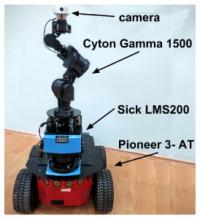Assistive robot arms

Robots that assist elderly or disabled persons in their day-to-day tasks can lead to a huge improvement in quality of life. At ROCON we are pursuing assistive manipulators, as well as UAVs for monitoring at-risk persons. This project focuses on the first direction, and presents a wide range of opportunities for a team of students, starting from low-level control design and vision tasks, to high-level control using artificial intelligence tools. Each student will work on one well-defined subtopic in these areas. Specific tasks include:
- Vision for detecting the position and state of the robot arm itself, as well as that of interesting objects in the environment -- such as a light switch, an object to retrieve, or the person being assisted.
- Control based on Euler-Lagrange modeling and nonlinear design.
- Motion planning, where we focus on so-called active perception: we plan the motion so as to decrease sensing uncertainty about the state of the world. For example, the robot might determine the type of an object by observing it from an optimal sequence of viewpoints.
- Rehabilitation robotics, where the robot arm is connected to the human arm and helps him to retrain after e.g. a stroke.
Initial results, where an asistive mobile manipulator turns off light switches, are showcased in the demo movie below. Current applications we target include domestic robotics, assistive manipulation in industrial settings, and rehabilitation robotics in collaboration with Polaris Medical. Available relevant hardware includes a Cyton Gamma 1500 robot arm, Kinect and similar 3D vision systems, and a OptiTrack 6DOF positioning systems.
Interested students should get in touch with any of the contact persons below to setup a meeting. Student skills that are interesting in this project range from fundamental math and control to ROS, C++ and Matlab real-time coding.
